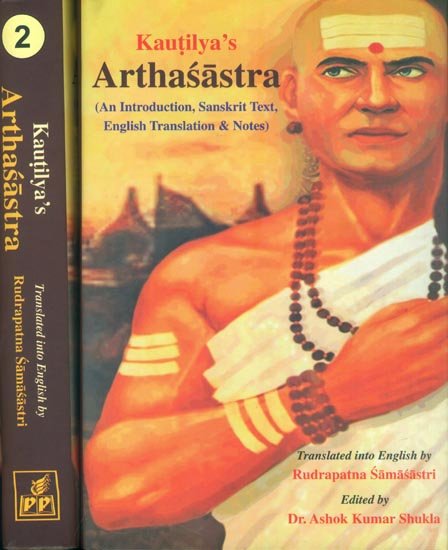Kautilya Arthashastra
by R. Shamasastry | 1956 | 174,809 words | ISBN-13: 9788171106417
The English translation of Arthashastra, which ascribes itself to the famous Brahman Kautilya (also named Vishnugupta and Chanakya) and dates from the period 321-296 B.C. The topics of the text include internal and foreign affairs, civil, military, commercial, fiscal, judicial, tables of weights, measures of length and divisions of time. Original ...
Introductory Note
The Kauṭilya-Arthaśāstra, of which Mr. Shamasastry gives us here his translation, is a work of very exceptional interest and value. In the first place, it ascribes itself in unmistakable terms to the famous Brāhman Kauṭilya, also named Viṣṇugupta, and known from other sources by the patronymic Cāṇakya, who, tradition tells us, overthrew the last king of the Nanda dynasty, and placed the great Maurya Candragupta on the throne: thus, the two verses with which the work ends recite that it was written by Viṣṇugupta, who from intolerance of misrule rescued the scriptures, the science of weapons, and the earth which had passed to the Nanda king, and that he wrote it because he had seen many discrepancies on the part of previous commentators; and, in conformity with a common practice of Indian writers, the name Kauṭilya figures constantly through the book, especially in places where the author lays down his own views as differing from others which he cites. The work accordingly claims to date from the period 321-296 b,c.: and its archaic style is well in agreement with the claim. Secondly, as regards its nature and value. Kauṭilya is renowned, not only as a king-maker, but also for being the greatest Indian exponent of the art of government, the duties of kings, ministers, and officials, and the methods of diplomacy. That a work dealing with such matters was written by him is testified to by various more or less early Indian writers, who have given quotations from it. But the work itself remained hidden from modern eyes until it was found in the text of which the translation is laid before us here. The topic of this text is precisely that which has been indicated above, in all its branches, internal and foreign, civil, military, commercial, fiscal, judicial, and so on, including even tables of weights, measures of length and divisions of time. And it seems to be agreed by competent judges that, though the existing text is, perhaps, not absolutely word for word that which was written by Kauṭilya, still we have essentially a work that he did compose in the period stated above. The value of it is unmistakable: it not only endorses and extends much of what we learn in some of its lines from the Greek writer, Megasthenes, who, as is well known, spent a long time in India as the representative of the Syrian king, Seleucus I, at the Court of Candragupta, but also fills out what we gather from the epics, from other early writings, and from the inscriptions, and explains statements and allusions in these last-mentioned sources of information which are otherwise obscure: in short, it throws quite a flood of light on many problems in the branch of Indian studies to which it belongs.
For our introduction to this work we are greatly indebted to Mr. Shamasastry. A manuscript of the text, and with it one of a commentary on a small part of it by a writer named Bhaṭṭasvāmin, was handed over by a Pandit of the Tanjore District to the Mysore Government Oriental Library. From these materials Mr. Shamasastry, who was then the Librarian of that Library, gave a tentative translation in the pages of the Indian Antiquary and elsewhere, in 1905 and following years. By the enlightened encouragement of the Mysore Durbar he was enabled to publish the text itself in 1909, as Vol. 37 of the Bibliotheca Sanskrita of Mysore. And under the same appreciative patronage he now lays before us a translation which has been improved in various details, in addition to being brought together in a connected and convenient form. His task has been no easy one. For the formation of his text, as for his translation of it, he has had only the one manuscript and the partial commentary which have been mentioned above: and the text is by no means a simple one; it is laconic and difficult to a degree. In these circumstances, it could hardly be the case that anyone should be able to give us a final treatment of the work straight away. It seems that, as a result of the attention which Mr. Shamasastry’s labours attracted at once, two or three other manuscripts of the work have now been traced. So it may be hoped that eventually another step may be made, by giving us a revised text, based on a collation of materials, which will remove certain obscurities that still exist. Meanwhile, it is impossible to speak in too high terms of the service rendered by Mr. Shamasastry, in the first place by practically discovering the work, and then by laying the contents of it before us so satisfactorily, in spite of the difficulties confronting him, which can only be appreciated by anyone who tries to understand the text without the help of his translation. We are, and shall always remain, under a great obligation to him for a most important addition to our means of studying the general history of ancient India.
20th November, 1914.
J. F. Fleet.
